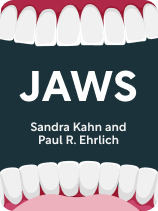

This article is an excerpt from the Shortform book guide to "Jaws" by Sandra Kahn and Paul R. Ehrlich. Shortform has the world's best summaries and analyses of books you should be reading.
Like this article? Sign up for a free trial here.
Did you know that ancient humans had better oral health than we do today? Why are jaw problems so common around the world? What can you do to prevent jaw deformities?
Jaws discusses how our modern lifestyle has created an epidemic of jaw deformities, leading to widespread health problems. Orthodontist Sandra Kahn and ecologist Paul R. Ehrlich say that a decrease in average jaw size is contributing to health issues.
Keep reading for an overview of Jaws: The Story of a Hidden Epidemic.
Jaws by Sandra Kahn and Paul R. Ehrlich
Jaws: The Story of a Hidden Epidemic (2018) discusses how our modern lifestyle has created a hidden epidemic of jaw deformities, leading to widespread health problems. In it, authors Sandra Kahn and Paul R. Ehrlich say that a decrease in average jaw size is contributing to serious health issues such as chronic pain and sleep apnea. The book calls on parents to help their children’s jaws develop in a healthy way in order to avoid these problems; it also asks doctors and scientists to recognize that modern-day jaw deformities are a serious issue and to give this issue the attention it deserves.
Kahn is a practicing orthodontist with over 25 years of clinical experience in her field. As such, she brings a wealth of hands-on knowledge to bear when discussing oral health and jaw development. She holds degrees from the University of Mexico and the University of the Pacific, as well as being certified by the American Board of Orthodontics.
Ehrlich is a distinguished biologist and ecologist, best known for his contributions in the field of population studies and his efforts to preserve biodiversity in nature. He’s a professor emeritus of Population Studies in the department of Biological Sciences at Stanford University and president of the Stanford Center for Conservation Biology. With research spanning from butterfly ecology to human overpopulation, Ehrlich contributes his vast knowledge of biology and epidemiology to Jaws.
We’ll start this guide by explaining the evolutionary background of our jaws and the harmful impact that modern lifestyles have on oral health. From there, we’ll discuss some of the harmful effects that come from having an underdeveloped or deformed jaw. Finally, we’ll explore some options to prevent or correct these jaw deformities.
Our commentary will provide additional evidence both for and against the authors’ ideas. We’ll also discuss some other factors that contribute to modern-day jaw problems. Finally, we’ll provide some tools and actionable advice to help you prevent or correct these issues as much as possible.
Ancient Humans Had Better Oral Health Than We Do
Kahn and Ehrlich begin by saying that our ancestors tended to have healthier mouths than we have now, even though they didn’t have dentists or toothbrushes. In this section, we’ll explain how ancient humans maintained their oral health by simply using their jaws as they were meant to be used. Then, we’ll discuss why modern lifestyles—and especially modern diets—are harming our jaws and teeth. Finally, we’ll give some statistics to illustrate the surprising scope of this problem.
Our Jaws Evolved for Heavy Use
The authors explain that ancient humans used their teeth for serious labor, such as tearing raw meat and grinding up uncooked vegetables. This intensive use caused them to develop strong jaw muscles and teeth, which naturally protected them from many of the dental problems we have today.
For instance, skeletons show that ancient humans wouldn’t have needed braces even if they could have made them, because their teeth naturally grew straight. They also wouldn’t have needed their wisdom teeth pulled, because their jaws were large enough to accommodate all of n this way—for example, think about how soft a cooked carrot is compared to a raw one.
These ready-to-eat foods mean our jaws don’t get the kind of exercise they’re evolutionarily designed for. As a result, many people today have underdeveloped or deformed jaws that can’t comfortably hold all their teeth, which causes teeth to come in crooked, out of place, or painfully crowded against each other. This is why braces and wisdom tooth extractions are so common now.
Furthermore, the authors say that our modern diet affects the type of bacteria that live in our mouths. Because we eat a lot of sugars and carbohydrates, different types of bacteria now thrive there, and those new bacteria happen to be types that promote tooth decay. This is another reason ancient humans had such good oral health, despite not having access to toothbrushes or dentists. their teeth. By contrast, both braces and extractions are common in modern society.
As further evidence for their claims, the authors say that animals show a similar pattern: Wild animals, whose food is harder to chew, typically have better oral health than domesticated animals. For example, a wild dog living on raw meat is likely to have stronger teeth than a pet dog who eats processed kibble and canned food.
Why Modern Diets Harm Our Jaws
Kahn and Ehrlich explain how modern lifestyles have drastically impacted jaw development and say that the main cause is our increasingly soft diet. Processed foods, along with technologies like blenders and food processors, mean that much of our food arrives “pre-chewed”: already partially broken down so it’s easier to eat and digest. Even cooking food starts to break it down i
Mouth Breathing Is a Contributing Factor
Although they don’t give it as much weight as modern soft diets, Kahn and Ehrlich say that breathing through your mouth is another factor that contributes to deformed jaws.
The authors explain that the tongue is supposed to act as a support for the palate and upper jaw. However, breathing through your mouth forces you to move your tongue away from the roof of your mouth so the air can pass through. Over time, especially in young children, this lack of support causes the upper jaw to sag and become narrower.
Mouth breathing also jeopardizes your oral health by drying out your mouth. Saliva plays an important role in neutralizing acids and flushing away bacteria. Therefore, if your mouth is chronically dry, you’re at increased risk of gum disease, tooth decay, and halitosis (bad breath).
Kahn and Ehrlich add that mouth breathing is especially common today because children spend much of their time in school: a closed environment with many other children where mild illnesses like colds spread easily. A child with a stuffy nose (as from a cold) will probably resort to breathing through their mouth just because it’s easier and more comfortable, and over time it becomes a habit that can last well into adulthood.
Jaw Problems Are Now Common All Around the World
Kahn and Ehrlich explain that having an underdeveloped jaw is now much more common than people realize, thanks to modern dietary habits. They cite a few statistics to illustrate the scope of the problem:
- A survey from the late 1990s showed that well over half of the US population needed some form of orthodontic treatment (such as braces, tooth extractions, or oral surgery).
- A study from 2007 found that almost two-thirds of people in Sweden needed orthodontic treatments.
- In a lecture at the Ancestral Health Symposium at Harvard University, one orthodontist said that 95% of people on Earth have misaligned teeth, with around 30% having misalignments severe enough to justify orthodontic treatments.
Clearly, this is not a rare or isolated problem: If the Harvard researcher is correct, it’s affecting billions of people today. In short, people all around the world are suffering from underdeveloped jaws, especially in developed countries where soft, highly processed food is the norm.
How Poor Jaw Structure Leads to Health Issues
Kahn and Ehrlich say that a deformed jaw doesn’t only cause dental problems, but can lead to broader health issues as well. In this section we’ll discuss some of the ways poor jaw structure can lead to chronic diseases.
Health Issue #1: TMJ Disorders
First of all, the authors say that a deformed jaw can lead to disorders of the temporomandibular joints (TMJs), which connect your jaw to the rest of your skull.
TMJ disorders have a wide variety of symptoms. The most common of these is chronic pain in the jaw area, especially while chewing or opening the mouth wide (such as when yawning). This can range from mild discomfort to severe pain, and in some cases it radiates into the neck and shoulder.
Other symptoms include clicking or popping sounds when opening or closing the mouth, locked jaw or limited mobility of the jaw, headaches, earaches, and facial pain. Some people also experience dizziness and tinnitus (ringing in the ears).
Health Issue #2: Sleep Apnea
Kahn and Ehrlich say that one of the most severe problems arising from poor jaw structure is sleep apnea, a condition where your breathing repeatedly stops and starts while you’re asleep. Sleep apnea happens because when you lie down to sleep, gravity can cause your tongue and other tissues to droop back into the oral cavity and block airflow. If your jaw is underdeveloped then the space in your mouth is already more crowded than it should be, making this more likely to happen.
Sleep apnea causes you to frequently wake up to catch your breath, which prevents you from sleeping deeply and restfully. Because of these sleep disruptions, sleep apnea is known to cause daytime fatigue, depression, and anxiety-related conditions like high blood pressure and heart disease. Young children who suffer from sleep apnea are also at risk for developing learning disabilities, behavioral issues, and psychiatric conditions like Attention Deficit Hyperactivity Disorder (ADHD).
Social Consequences of a Deformed Jaw
Kahn and Ehrlich don’t just talk about the physical health issues caused by deformed jaws—they also discuss the possible social impacts of such deformities.
Visibly crowded or crooked teeth can seriously harm people’s self-image and self-confidence. Although that’s not a health condition per se, it does impact their happiness, and therefore their overall well-being. Children and teenagers are especially vulnerable to this: Their peers are likely to bully them for looking different, which can seriously harm their mental and emotional health.
A deformed jaw can also make it hard to speak clearly, which naturally makes communication more difficult. This can hinder people’s ability to make friends, and it can also hold them back professionally—people who have trouble communicating will probably have a harder time finding work, especially in any sort of managerial or leadership role.
How to Prevent and Correct Poor Jaw Structure
So far we’ve discussed why modern people’s jaws are often deformed and some of the health problems those deformities can cause. We’ll conclude this guide by exploring some of the practices that Kahn and Ehrlich suggest to promote strong jaw development and boost your overall oral health.
The authors add that these measures are especially effective—and important—for children. This is because childhood is a critical growth phase: Jaw development during these formative years can shape not only a person’s dental health, but their overall quality of life well into adulthood. Therefore, Kahn and Ehrlich urge parents to take particular note of these practices and help their children implement them.
Practice #1: Chew More
Recall that many modern jaw and tooth problems are the result of not chewing enough. Therefore, the most obvious solution is to chew your food more—and, if you have children, encourage them to do the same.
Kahn and Ehrlich say that you should spend at least 30 minutes of each day chewing. You can accomplish this by being mindful while eating: Take small bites and chew each mouthful thoroughly before swallowing. Food should be nearly liquid before you swallow it, so if there are any noticeable chunks left, then you haven’t chewed enough. This also has the added benefit of helping you digest your food more easily.
The authors also suggest incorporating tougher foods into your family’s meals, such as whole fruits and raw vegetables. Not only will this force you (and them) to chew more thoroughly—swallowing chunks of such foods would be very unpleasant—they’re also harder to bite through, giving your jaw a better workout. Also, avoid processed foods like packaged bread and frozen dinners as much as possible, because they’re much softer than the types of food your jaw has evolved to eat.
Practice #2: Good Oral Posture
Kahn and Ehrlich say that how you hold your mouth normally—meaning while you’re not talking, eating, or doing something else that uses your mouth—plays a significant role in your jaw development and overall oral health. Orthodontists refer to this as oral posture.
Having proper oral posture means that your tongue rests against the roof of your mouth, your lips are closed, and your teeth are lightly touching each other. This position helps to shape your jaw and palate (the roof of your mouth), ensuring that they’re wide enough to comfortably house all of your teeth. Therefore, they advise you to maintain this position as much as possible, and encourage your children to do so as well.
Practice #3: Regular Dental Care
Finally, Kahn and Ehrlich say that preventative dental measures are also key for long-term oral health. Regular visits to the dentist can help identify early signs of issues such as crowding of teeth or potential gum diseases and can treat those conditions if you’re already suffering from them. The authors also advise getting regular dental care for your children, which they say may be even more important than getting it for yourself.
The authors also say that a good dentist or orthodontist should be familiar with forwardontics, which is more formally known as orthotropics. This is a program to evaluate your jaw structure and tooth alignment, identify problems or potential future problems, and treat those problems using various tools and techniques that promote healthy jaw development. In most cases, Kahn and Ehrlich favor this holistic approach over more common dental procedures. For instance, they say that wisdom tooth extractions are usually unnecessary and risk causing permanent damage to the patient’s jaw, teeth, or nerves.

———End of Preview———
Like what you just read? Read the rest of the world's best book summary and analysis of Sandra Kahn and Paul R. Ehrlich's "Jaws" at Shortform.
Here's what you'll find in our full Jaws summary:
- How our modern lifestyle has created a hidden epidemic of jaw deformities
- How a decrease in average jaw size is contributing to health problems
- Three ways to prevent or correct jaw deformities






